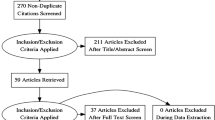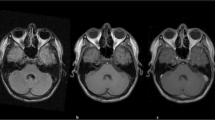Abstract
Introduction
Rosette-forming glioneuronal tumors (RGNTs) that do not involve the fourth ventricle are rare. RGNTs were originally thought to be exclusively localized into the fourth ventricle but were found in various anatomical localizations.
Material and methods
We review the literature and found 32 cases of this particular RGNT. The outcome was excellent with no mortality reported after surgical treatment. Only two patients had received adjuvant therapy for progression. We added one case of a RGNT located in the cerebellar hemisphere.
Case and conclusion
She underwent a subtotal removal with no evidence of progression after. This WHO grade I tumor with a specific biphasic histopathology is of a good oncological outcome after surgical treatment. A long follow-up is needed as recurrence or metastatic progressions exist.


Similar content being viewed by others
References
Schlamann A, von Bueren AO, Hagel C et al (2014) An individual patient data meta-analysis on characteristics and outcome of patients with papillary glioneuronal tumor, rosette glioneuronal tumor with neuropil-like islands and rosette forming glioneuronal tumor of the fourth ventricle. PLoS One 9:e101211. doi:10.1371/journal.pone.0101211
Kuchelmeister K, Demirel T, Schlörer E et al (1995) Dysembryoplastic neuroepithelial tumour of the cerebellum. Acta Neuropathol (Berl) 89:385–390
Komori T, Scheithauer BW, Hirose T (2002) A rosette-forming glioneuronal tumor of the fourth ventricle: infratentorial form of dysembryoplastic neuroepithelial tumor? Am J Surg Pathol 26:582–591
Chen S-Y, Wang W, Wang L-M, et al. (2015) Glioneuronal tumors with features of RGNTs and DNTs: a report of three cases. Histopathology. doi: 10.1111/his.12750
Louis DN, Ohgaki H, Wiestler OD et al (2007) The 2007 WHO classification of tumours of the central nervous system. Acta Neuropathol (Berl) 114:97–109. doi:10.1007/s00401-007-0243-4
Thurston B, Gunny R, Anderson G et al (2013) Fourth ventricle rosette-forming glioneuronal tumour in children: an unusual presentation in an 8-year-old patient, discussion and review of the literature. Childs Nerv Syst ChNS Off J Int Soc Pediatr Neurosurg 29:839–847. doi:10.1007/s00381-012-1993-4
Hsu C, Kwan G, Lau Q, Bhuta S (2012) Rosette-forming glioneuronal tumour: imaging features, histopathological correlation and a comprehensive review of literature. Br J Neurosurg 26:668–673. doi:10.3109/02688697.2012.655808
Zhang J, Babu R, McLendon RE et al (2013) A comprehensive analysis of 41 patients with rosette-forming glioneuronal tumors of the fourth ventricle. J Clin Neurosci Off J Neurosurg Soc Australas 20:335–341. doi:10.1016/j.jocn.2012.09.003
Chiba K, Aihara Y, Eguchi S et al (2014) Rosette-forming glioneuronal tumor of the fourth ventricle with neurocytoma component. Childs Nerv Syst ChNS Off J Int Soc Pediatr Neurosurg 30:351–356. doi:10.1007/s00381-013-2216-3
Maiti TK, Arimappamagan A, Mahadevan A et al (2015) Rare pathologies in the posterior third ventricular region in children: case series and review. Pediatr Neurosurg 50:42–47. doi:10.1159/000369033
García Cabezas S, Serrano Blanch R, Sanchez-Sanchez R, Palacios Eito A (2015) Rosette-forming glioneuronal tumour (RGNT) of the fourth ventricle: a highly aggressive case. Brain Tumor Pathol 32:124–130. doi:10.1007/s10014-014-0195-z
Yamamoto T, Matsubara T, Satomi K, et al. (2015) Rosette-forming glioneuronal tumor originating in the hypothalamus. Brain Tumor Pathol. doi: 10.1007/s10014-015-0226-4
Scheithauer BW, Silva AI, Ketterling RP, et al. (2009) Rosette-forming glioneuronal tumor: report of a chiasmal-optic nerve example in neurofibromatosis type 1: special pathology report. Neurosurgery 64:E771–772; discussion E772. doi: 10.1227/01.NEU.0000340979.81362.F3
Anan M, Inoue R, Ishii K et al (2009) A rosette-forming glioneuronal tumor of the spinal cord: the first case of a rosette-forming glioneuronal tumor originating from the spinal cord. Hum Pathol 40:898–901. doi:10.1016/j.humpath.2008.11.010
Solis OE, Mehta RI, Lai A et al (2011) Rosette-forming glioneuronal tumor: a pineal region case with IDH1 and IDH2 mutation analyses and literature review of 43 cases. J Neurooncol 102:477–484. doi:10.1007/s11060-010-0335-1
Author information
Authors and Affiliations
Corresponding author
Ethics declarations
Conflict of interest
Authors declare no conflict of interest.
Rights and permissions
About this article
Cite this article
Beuriat, PA., Tauziede-Espariat, A., Pages, M. et al. Rosette-forming glioneuronal tumor outside the fourth ventricle: a case-based update. Childs Nerv Syst 32, 65–68 (2016). https://doi.org/10.1007/s00381-015-2922-0
Received:
Accepted:
Published:
Issue Date:
DOI: https://doi.org/10.1007/s00381-015-2922-0




